Experience expert Kevin Dulle explores the vital role that the setting of the experience – and the environment it creates – plays in the overall enjoyment of the experience, and how experience designers can seek to create liminal zones that both heighten the sense of anticipation beforehand and gently ease people back into the real world afterwards.
Catch up on Persona Of Place: Characterizing The Stage Within The Experience Economy and Persona Of Place Part Two: The Bundling Of Place Personae here.
You’ve designed the experience and filled the space with props and scenery via fixtures, artwork, color and décor. The stage is set for the cast and customers. The former are your staff that must perform their roles as dictated by the script of the experience.
Unfortunately, some designers have forgotten that there’s another cast member whose role leads the performance and defines the overall experience – the place itself and the environment that contains the experience.
This environment is the world of the experience. It’s the world you created to house the experience, which has a unique role to play. This world you’ve created has a personality and is as unique as the experience itself.
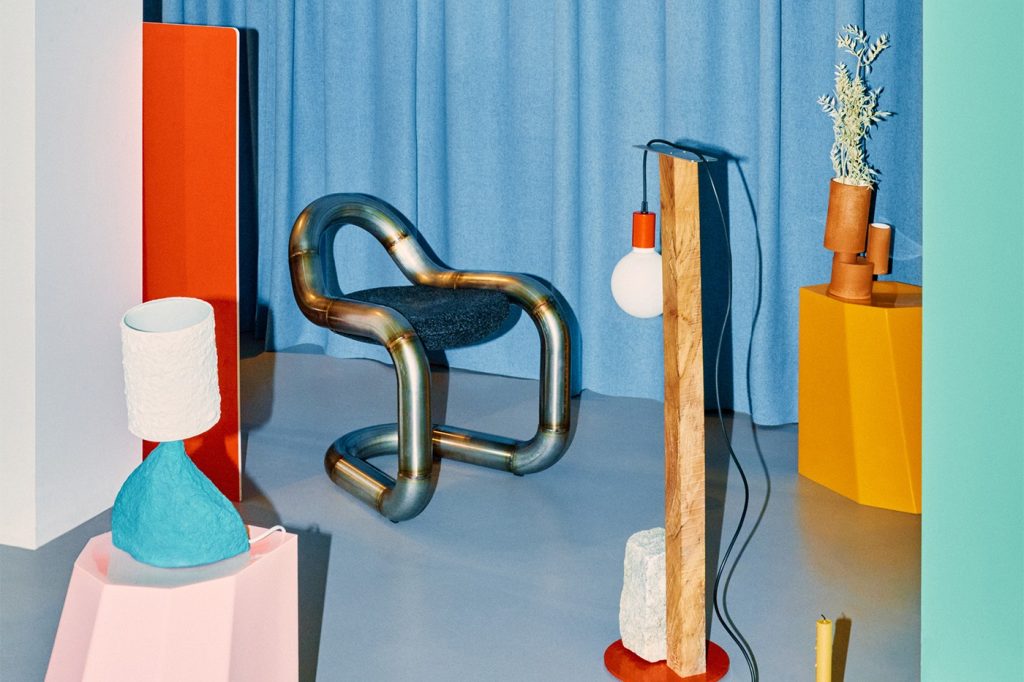
What Defines This World Of The Experience?
To better understand the world of the experience, we first need to look at the journey a customer takes when visiting the experience you designed. The journey can best be identified by a sequence or flow. The flow of an experience typically has five key drama stages: Enticing, Entering, Engaging, Exiting, and Extending.
Not all five of these phases define the world of the experience. In fact, only three exist within the world: Entering, Engaging, and Exiting. Enticing and Extending are external phases that exist as the outer world and are not shaped solely by the designer or incorporated into the world created. The world of the experience has unique properties that can be identified by various characteristics. It is these characteristics that help shape the place persona.
Before diving into place personae, the influence factors need to be defined to help establish the key variables that define the various place personae. These variables help define the characteristics unique to each persona and help establish the function or role of the place itself.
As stated earlier, there are three phases of the flow of an experience that define the world or place where an experience exists: Entering, Engaging, and Exiting. Each can provide three variations that help impact the overall effect on the experience.

Liminal Zones
The Entering phase is in fact a liminality from the outer world into the world of the experience and exists in both. It is the in-between state. To make things even stranger, this liminal zone of Entering spans both time and space and is a liminality defined by duration and distance of travel from the outer world to the inner world. A duration and distance that can be identified in three values for ease of explanation. These values that define the type of entering action are (H) Hasten, (M) Maintain, and (L) Linger.
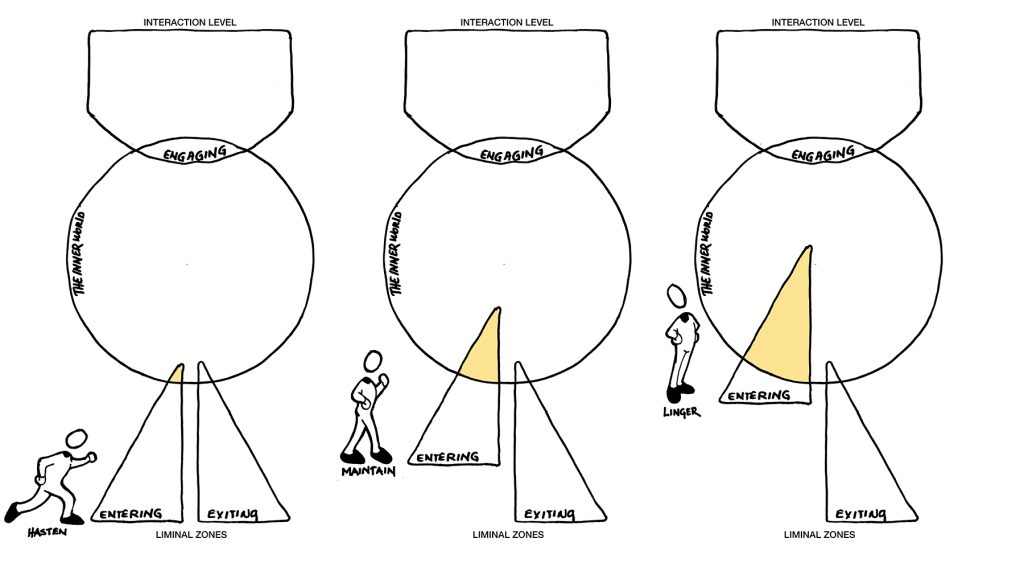
Hasten can typically be identified like a doorway threshold. There’s an almost immediate transition from the outer real world to the inner world of the experience. The time and space to traverse this liminal zone are minimal or instantaneous. A typical application of a Hasten Entering phase is that of most stores. Once the door is opened and you step through, you’re inside the place. There is no expectation or gradual transition through the zone, much like Alice stepping through the looking glass…
Maintain offers a bit more transition action. It can appear like that of a foyer or entrance gate where both worlds can be identified, but not existing in either completely. Maintain liminal zones can create a sense of anticipation without revealing the complete world. Take the example of ‘O’ by Cirque De Solei in Las Vegas. The lobby functions as a Maintain liminal zone; it’s not quite inside the world of the experience, yet has many of the elements that hint to the world beyond the next set of doors that lead deep inside the theater. This zone creates a sense of anticipation.

Linger liminality is just that; a duration that offers a longer time and space to build even greater anticipation. It can almost become an experience within itself. A good example of a Linger liminal zone is the plane flight from your hometown to Las Vegas, Orlando, or Paris. The plane transports you from one location of your world to the destination of another different from your own. The distance and time it takes is long and lingering. The transition begins as you board the plane, train, or even hop into your car to drive to the experience.
At any Disney property, the Linger liminal zone is the entrance area or gate. You can sense the world beyond by the sounds, sights and even smells from beyond the ticket counter. You can see the world, but you’re not quite inside it.
Just as Entering has these three values, so too, does Exiting, which uses the same three values for different reasons and outcomes. The exiting zone can be like the Hasten of Entering, rushing from the inner world of the experience to the outer real world. Take the example of exiting a cinema in the middle of the afternoon. The theater is dark and your eyes have adjusted to the darkness when suddenly, light burst in as the exit doors swing open. On one blind step you transition from the confines of the theater to the noise and sunlight of the world outside. It’s a shock to the system and offers little duration to reflect.
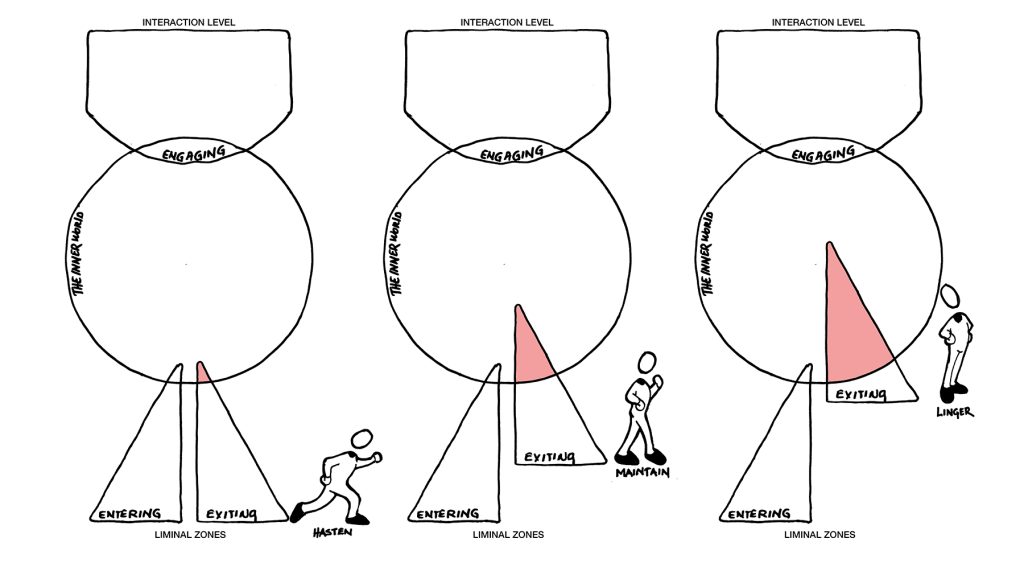
The Maintain liminal zone offers a slower transition from the world experienced to the return of the world outside. Many times, this transition takes the form of secondary spaces like gift shops at museums or souvenir stores at the exits of parks. The spaces are not quite the experience inside the world but have many of the elements that remind you of where you were. It provides a moment where customers have time to purchase memorabilia as reminders of their visit.
Then there is the Linger liminality zone of exiting; a slow transition almost to the point of being a rest stop or a lounge area. It’s a point in the transition that the customer can stop or slow down to gather their thoughts and relax. Starbucks uses this concept of lingering with the use of the seating lounge space. You buy your coffee and then relax in what has been termed the ‘third’ place. Disneyland in Orlando offers visitors an optional boat ride back to the parking lot, allowing for a moment to look back at the park and reflect on the day’s experiences. The Linger liminal zone is still part of the world, but also is a slow transition back into the real outer world.
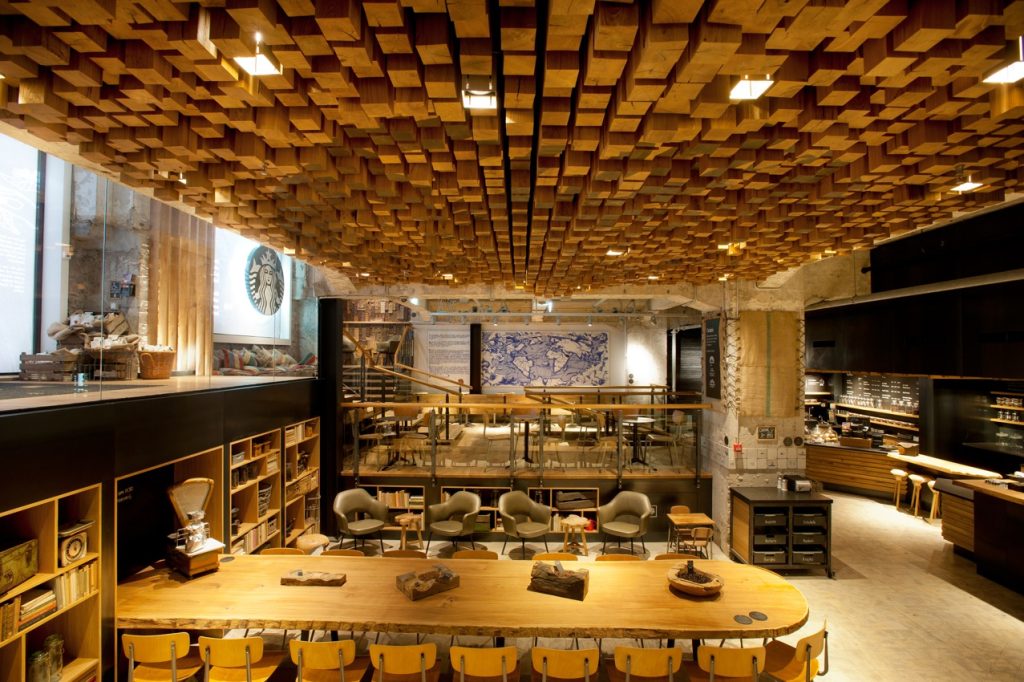
Levels Of Engagement
Just as Entering and Exiting have three values, Engaging has its three values. Unlike that of liminality, Engaging is more about the level of engagement of the experience. These values are (A) Absorb, (E) Engage, and (I) Immerse. A range of interaction with the stage experience can be best described “You See it”, of Absorb, “It’s about you” of Engage, and “You are it” of Immerse.
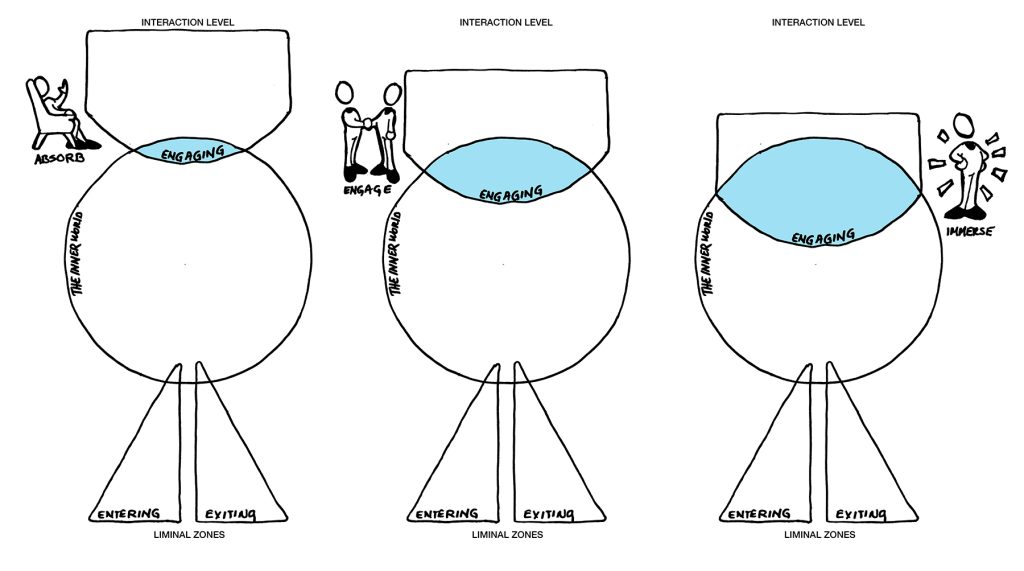
The engagement of Absorb is that of seeing or witnessing the experience from afar. Movies, concerts, or even books are all experiences at the level of absorb. You have no impact on the flow or outcome of the experience. You are merely a spectator.
For experiences where the engagement is about you the customer, there is the Engage value. In the Engage experience, the focus is to you the customer. Starbucks baristas are the performers of the action but are doing it for you; they make your coffee the way you like it, you do not. You are the conductor of the experience rather than the performer.
Finally, there is Immerse. The Immerse value is best identified as an experience where you are the experience, or you are doing the actual action. Rough Mudders is a great example of this level of engagement. The designers only create the environment framework, it is the customer or participant that produces the experience. Another is Build-A-Bear, where the child builds the soft toy of their design – the store and staff are merely there to guide the customers through the building experience.
Defining The Place Persona
The three key phases of an experience each have three values. The various combinations create 27 unique Place Personae. It is these combinations of values that provide the framework of function for each persona. Each Place Persona has a unique role to play. Not all personae are applicable to every staged experience. In fact, the wrong persona could be like a bad performer and ruin the experience.
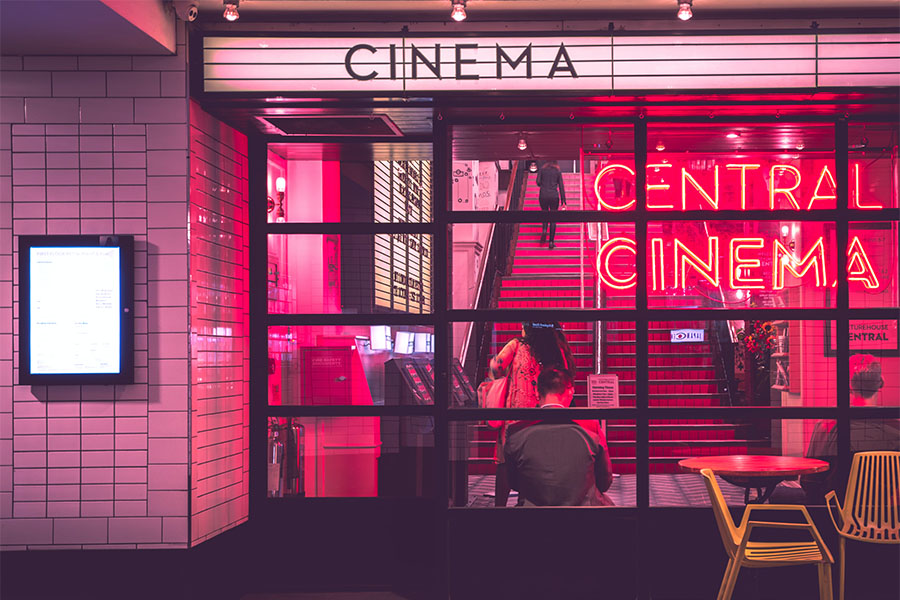
Examples Of Place Personae
The following are examples of Place Personae using a letter sequence to identify the values, starting with Entering, then Engaging, and lastly Exiting. Entering and ‘Exiting’ will share the same letter sequences as the share the same duration factors of H for Hasten, M for Maintain, and L for Linger. The Engaging phase will use A for Absorb, E for Engage, and I for Immerse. Each persona will have a three-letter determination based upon each value.
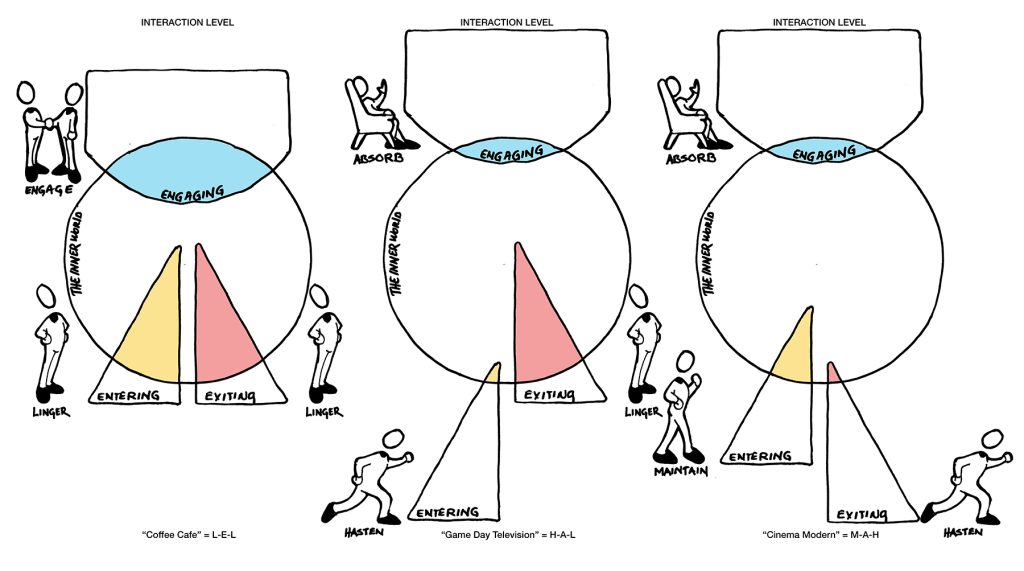
- “Coffee Cafe” = L-E-L: The application here is like that of Starbucks cafés. There is the entering lounge space leading up to the barista counter that uses lingering as part of its design. The ordering or conducting of the coffee order, which is at the level of Engage, and finally back to linger for the same lounge space as entering.
- “Cinema Modern” = M-A-H: Lobby provides the ‘Maintain’ Entering zone, ‘Absorb’ is the value of the experience, and ‘Hasten’ is the typical exiting process.
- “Game Day Television” = H-A-L: That party place or pub that you go to see your favorite sporting event. Step through the door inside using the ‘Hasten’ Entering. Watching the game on the big screen is an Absorb level of engagement. Then there is the time you spend sitting around celebrating or consoling each other after the game.
These are just three of the 27 Place Personae. Try to construct and then give your construct a persona name to help identify the characteristic of the place.
Beyond the single place persona, a collection of place personae can also be created. These collections can embrace various personae with an overall Place Persona of the collection.
Place persona collections can manifest as theme parks, multiple activity events, and even holiday venues giving each event or place a character to complement the theme.
To get more insights from experts in the Experience Economy – and to be the first to know about our membership programme, events and more – apply to join the WXO now.






